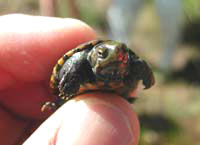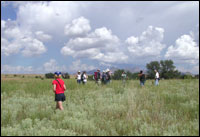Trevor Hare is the field coordinator for Sky Island Alliance, a group dedicated to protecting biodiversity in the sky island mountain ranges of the southwestern United States.

Monday, 17 Sep 2001
TUSCON, Ariz.
It’s hard going back into the office after spending a gorgeous Sunday wildlife tracking in the southeastern Arizona desert grasslands of the Appelton-Whittel Audubon Research Ranch. The Sky Island Alliance uses volunteers to ground-truth wilderness proposals, delineate roadless areas, and track large mammals that travel across these desert grasslands between the sky island mountain ranges. Yesterday, we had more than 20 volunteers, mostly new, to help monitor four track transects across this awesome landscape. As the field and volunteer coordinator and a conservation biologist for the Sky Island Alliance, I feel good knowing that we are not only investigating corridor use by animals, but also building strong and lasting advocacy groups in the protection of the landscapes of southern Arizona.

Sonoran mud turtle.
We didn’t find a lot of tracks or signs, but what we did find is encouraging: a small Sonoran mud turtle (Kinosternon sonoriense) and two black-necked garter snakes (Thamnophis crytopsis), both riparian obligate species. Our finds show the resilience of these desert grasslands where, after 100 years, grazing was halted and all cattle removed in 1968. We also found what we think is black bear (Ursus americanus) scat. Bears have been verified crossing the research ranch before, most likely between the Huachuca and Santa Rita Mountains.
Back in the office, the first thing I have to do is send thank-you notes to our volunteers and the hosts at the research ranch. Then it’s time to break out the topo maps of our next field weekend and figure out what roads we will have our volunteers walk and what information we need to collect. The next weekend is in the Gila Mountains of southeast-central Arizona. The Gila Mountains contain the Fishhook Wilderness and a BLM Wilderness Study Area. We will collect data on characteristics and conditions of the roads that enter these two areas and record all animal and plant species that make this area unique.

Volunteers in the field.
With this information, we will build a case for road-closures and expanded wilderness in this rugged, remote, and rarely visited area that even BLM land managers have very limited information on. We also hope to make contact with the people who do actually know a bit about this area: the ranchers who run their cattle on the BLM grazing allotments that surround the existing and proposed wilderness. These are the people who know what’s out there and who can help to protect the wilderness values of the area by fencing the few riparian areas, by moving their cattle more frequently, or by perhaps lowering their stocking rates. We are dedicated to keeping lands surrounding wilderness areas as wild lands that can support local stewards, economies, and connectivity between wilderness and other preserved lands administered by the BLM and Forest Service.
Wednesday, 19 Sep 2001
TUSCON, Ariz.
Back in the office. Tuesday was a day off, as I will work all weekend in the Gila Mountains. Today, the fun stuff happens: confirming attendance for the weekend work, getting the maps straightened out, photocopying the applicable portions, and getting the volunteer field packs ready. Then it will be on to fund-raising — yea!
October is the big fund-raising month for the Sky Island Alliance; we have many talks and presentations scheduled, as well as an open house and a volunteer appreciation party. I am in charge of finding donations of food and drinks for the open house, and I have already hit up 10 of the finest restaurants in Tucson. Now, it is time to give those restaurants a call back and confirm with them. Then, it is on to calling our volunteers — over 200 strong — to confirm attendance at the big volunteer party we will be hosting in one of the most beautiful mountain ranges in the sky island region, the Dragoons. The Dragoons are also the setting for some of the most advanced work we have done. We have already closed a road in the area and have been working with local ranchers to figure out how their operations can benefit habitats and wildlife. It is very exciting to see our visions being realized on the ground.
New email with more volunteers for this weekend’s work! I have been pretty diligent in trying to get kids out with us. One of our leading tenets is building advocacy groups and, of course, I have been trying to get as many University of Arizona students as possible interested in what we are doing. Too many of the kids over there are business majors, with visions of great riches dancing in their heads. Unfortunately, most of them don’t realize that all riches are derived from natural capital, and that we first need to protect and enhance that natural capital.
One other task today is to confirm that the International Conference on Ecology and Transportation is still going on in Keystone, Colo., and that my flight is still booked. One of the major barriers to animal movements in the sky island area is Interstate 10, and it will be very important to have strategies and plans in place as the Arizona Department of Transportation envisions upgrading I-10 as the population in southern Arizona continues to grow. I will be in Colorado all next week looking at and learning how other states have incorporated large mammal crossings into their transportation plans.

